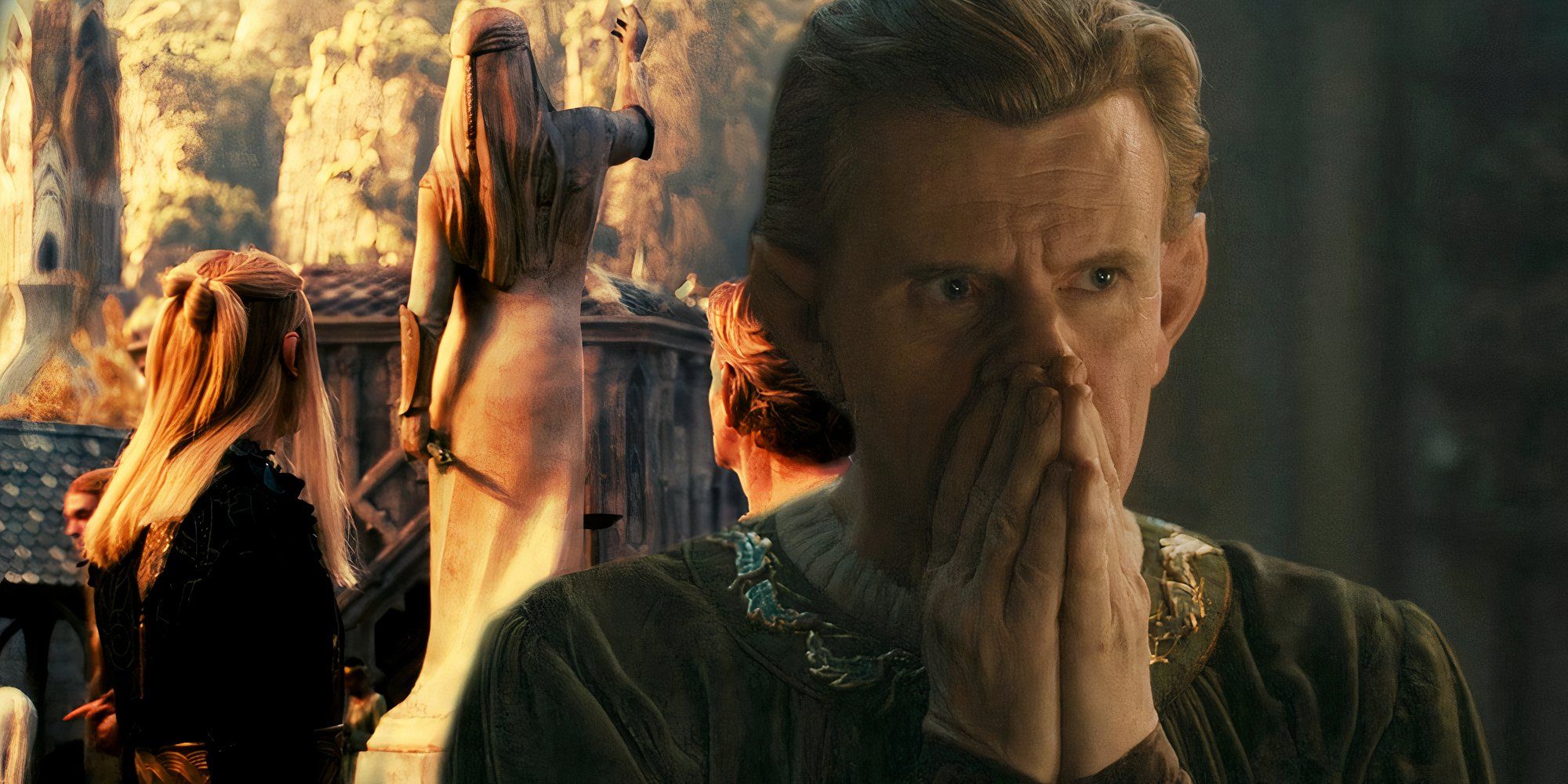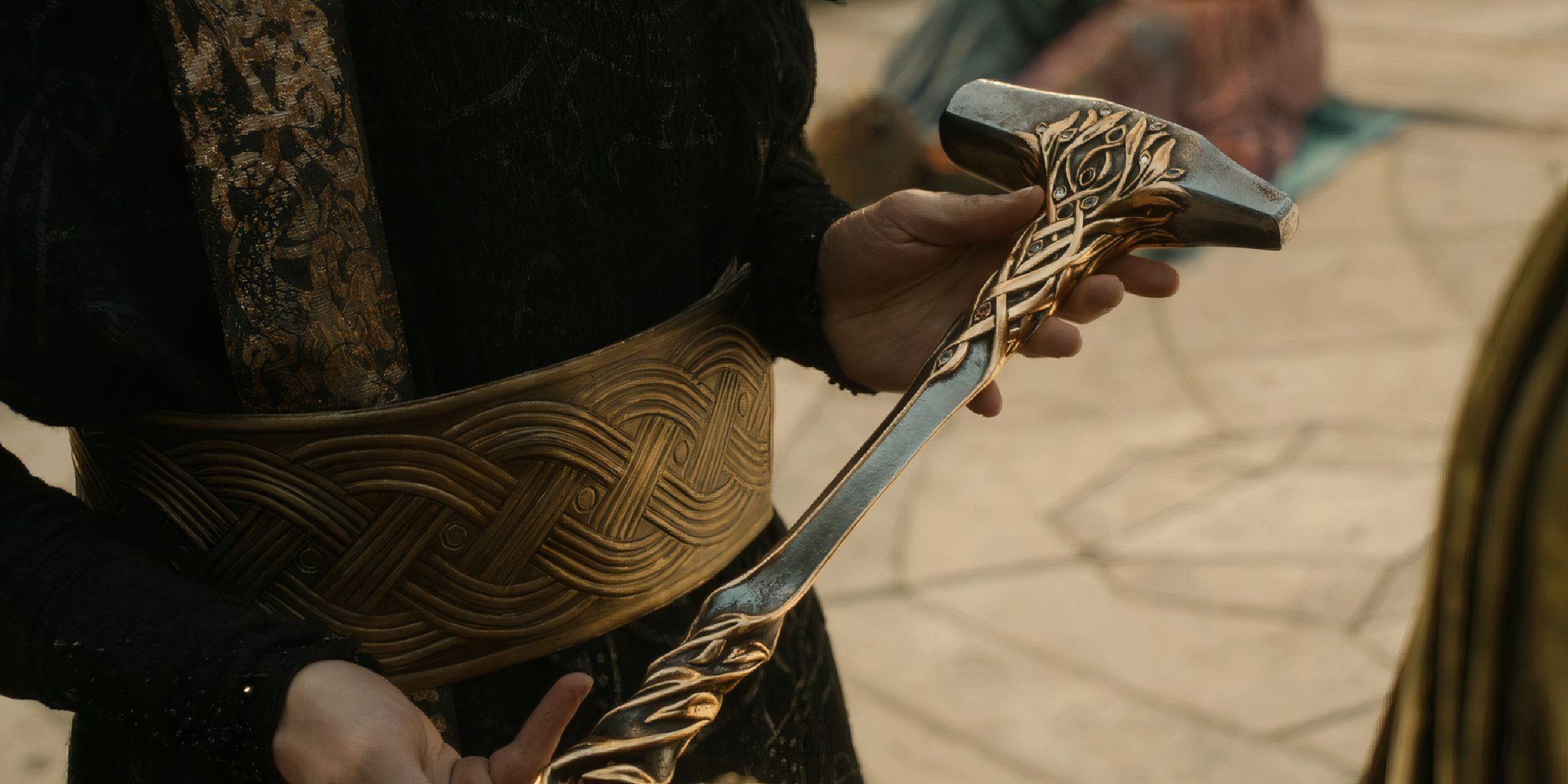Warning! Spoilers for Rings of Power season 2, episode 6 ahead.
A statue stands in Eregion in The Lord of the Rings: The Rings of Power, and it depicts a figure deeply important to the lore of Lord of the Rings. The fictional world that author J.R.R. Tolkien constructed is full of such characters who played important roles in the First Age of Middle-earth (and even before). While Rings of Power is set about halfway through the Second Age, these important Elves, Men, and Dwarves are still remembered for their deeds. The elf commemorated by Eregion’s statue carries supreme importance for Celebrimbor and, therefore, the events of Rings of Power season 2.
Eregion is a significant location in Prime Video’s Rings of Power since this is where Celebrimbor and Annatar (really Sauron) create the titular Rings of Power. Unfortunately, the city’s future is pretty bleak since Adar and his Orcs have Eregion surrounded in Rings of Power season 2, episode 6. It’s about this time that Lord Celebrimbor steps outside his forge to what should be a city at siege and stands at the feet of Eregion’s statue. However, Sauron made the city circle appear to be a peaceful paradise and used Celebrimbor’s reverence for the statue against him.
The Statue In Eregion In The Rings Of Power Depicts Fëanor
Fëanor Is Among The Most Notable Figures In Middle-earth History
The statue in Eregion is an elf holding a hammer and is confirmed in Rings of Power to be a depiction of Fëanor, a former king of the Ñoldor Elves. Fëanor was known to be a craftsman beyond the skill of anyone else and, in Rings of Power, a figure that Celebrimbor both envied and respected. He was born a prince in Valinor, son of High King Finwë, and was greatly loved by his people. Fëanor was highly intelligent and the inventor of Tengwar, the Elvish script still used during Frodo’s time in The Lord of the Rings. He also created the palantíri seeing stones.
Of course, these weren’t Fëanor’s most noteworthy creations. This elf was the one who crafted the three Silmarils, which he made to capture the beautiful light of the Two Trees of Valinor. Fëanor was intensely proud of these stones and was known to wear them across his brow so all could marvel at their beauty. Melkor, who had already stirred up trouble (as in devastating wars) in Middle-earth but was given a second chance by the Valar, grew to covet the Silmarils. So, the villain slowly began to manipulate Fëanor, inspiring jealousy and distrust in the elf’s heart.
Fearing that his own people (and the Valar) would try to steal the Silmarils, Fëanor hid them away. However, Melkor knew where, and he (and the spider-like being Ungoliant) destroyed the Two Trees of Valinor to distract the Elves and Valar from Fëanor’s hiding place. Melkor (who then became known as Morgoth) escaped Valinor to Middle-earth. It’s for this reason that Fëanor led the Ñolder to follow Morgoth to Middle-earth against the will of the Valar, resulting in their exile from Valinor. Unfortunately, it never proved worth it to Fëanor since he was killed by a Balrog before ever retrieving his precious Silmarils.
The Silmarils’ History In Tolkien Mythology Explained
The Beautiful Silmarils Caused A Whole Lot Of Trouble
Fëanor’s Silmarils continued to be a point of interest in Middle-earth long after his death. Morgoth fixed the three glorious stones to his crown—the same crown Adar murdered Sauron with in The Rings of Power—where they stayed for centuries. Eventually, a man named Beren was tasked with retrieving one of the Silmarils to be granted the hand of his elvish love, Lúthien. While he succeeded in stealing one from Morgoth’s crown, it came at the tragic cost of his life. Later, this stone fell to the half-elf Eärendil, who, with his wife, brought it to Valinor to beg the Valar for help in the fight against Morgoth.
Later, this stone fell to the half-elf Eärendil, who, with his wife, brought it to Valinor to beg the Valar for help in the fight against Morgoth.
The Valar granted Eärendil’s request, came to Middle-earth to battle Morgoth, and bound the villain to be again locked away. The Silmaril, on the other hand, was sent with Eärendil into the heavens, where it became the star Gil-Orestel. Two of Fëanor’s sons, Maedhros and Maglor, stole the other two Silmarils, though the stones burned their hands. One fell into the earth, while another fell into the sea. So, during the events of The Rings of Power and The Lord of the Rings, there is a Silmaril in each realm of Arda.
Why Fëanor’s Statue Is Important For The Rings Of Power Season 2’s Story
Celebrimbor Is Desperate To Surpass Fëanor’s Legacy
The story of Fëanor and the Silmarils is a messy one. The elf was doomed by his pride, and he dragged his people with him. While the Ñoldor exile was eventually lifted, the stain of their acts when leaving Valinor (the kinslaying) stuck with them for centuries. Still, Fëanor is clearly revered by the Elves of Eregion in Rings of Power. He hadn’t been a perfect king, but his creations made the elf a figure of great renown in Middle-earth. As a craftsman, this is the sort of reputation that Celebrimbor is desperate for. He wants to create something that earns him a reputation even greater than Fëanor.
Celebrimbor and Sauron are the Second-Age versions of Fëanor and Morgoth, and this moment in front of this meaningful statue in
Rings of Powe
r season 2 drives this fact home.
Sauron knows this about Celebrimbor and uses it against the elf in The Rings of Power season 2. When the Lord of Eregion left his forge, concerned for his people, the Dark Lord used his magic to transform the circle and calm Celebrimbor’s fears. He then handed him the hammer of Fëanor—at the feet of the legendary elf’s statue—and essentially challenged him to complete his work and put his name in the same league as the great smith. Celebrimbor simply couldn’t resist. So, though all the alarms were going off in his head, he went back into the forge with Sauron to make the Rings of Power.
Sauron and Celebrimbor talk behind the statue of Fëanor in
Rings of Power
season 2, episode 6, further emphasizing Celebrimbor’s feeling that he has yet to surpass the legendary smith’s legacy.
There’s a good deal of symbolism and foreshadowing going on here as well. Celebrimbor is doomed to get his wish since he will go down in Middle-earth’s history as the creator of the remarkable Rings of Power. Of course, like Fëanor, he will also be remembered for the pride and envy that make him so susceptible to manipulation. Celebrimbor and Sauron are the Second-Age versions of Fëanor and Morgoth, and this moment in front of this meaningful statue in Rings of Power season 2 drives this fact home.

